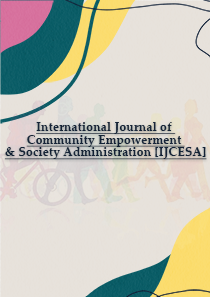International Journal of Community Empowerment & Society Administration [IJCESA]
Citation :
Gokul G, Rengaraj, 2025. "Grassroots Innovation for Inclusive Growth: A Study of Community-Lead Sustainable Development " International Journal of Community Empowerment & Society Administration [IJCESA] Volume 2, Issue 1: 36-46.
Abstract :
Solutions to everyday challenges formulated by communities are termed "grassroots innovation," and have evolved into an important avenue for sustainable and equitable development. Community-led innovations promote inclusive growth by improving livelihoods, expanding services and local capacity in a way that also preserves environmental resources, we learn in this article. The paper identifies means through which grassroots innovation enhances social inclusion, economic resilience, and ecological sustainability based on a mixed-methods approach that reviews the literature, analyses illustrative case studies (Honey Bee Network innovations; community-based energy initiatives; water harvesting) and proposes an empirically applicable analytical framework. The main findings are that: (1) local institutions and learning networks assist diffusion and scaling; (2) the role of enabling policy environments, as well as intermediary actors (e.g., civil-society networks, incubators), is critical; and (3) bottom-up innovations lead to greater access and affordability of essentials for the poor. Aside from providing an operational monitoring tool to measure contributions to inclusive growth, the report also provides a set of policy-making recommendations on how grassroots innovation can be elevated into national development strategies.
References :
[1] Anil K. Gupta & Honey Bee Network. (various years). Documentation and reports on grassroots innovations.
[2] Radjou, N., Prabhu, J., & Ahuja, S. (2012). Jugaad Innovation: Think Frugal, Be Flexible, Generate Breakthrough Growth. Jossey-Bass.
[3] Schumacher, E. F. (1973). Small Is Beautiful: Economics as if People Mattered. Harper & Row.
[4] Sen, A. (1999). Development as Freedom. Oxford University Press.
[5] United Nations. (2015). Transforming our world: the 2030 Agenda for Sustainable Development. UN General Assembly.
[6] Moulaert, F., MacCallum, D., Mehmood, A., & Hamdouch, A. (2013). The International Handbook on Social Innovation. Edward Elgar.
[7] Radjou, N. & Prabhu, J. (2015). Articles and commentaries on frugal innovation in development contexts.
[8] World Bank. (2018). Reports on inclusive growth and local development (World Development Report and related documents).
[9] United Nations Development Programme (UNDP). (Annual). Human Development Report.
[10] Hargadon, A. (2003). How Breakthroughs Happen: The Surprising Truth About How Companies Innovate. Harvard Business School Press.
[11] Howaldt, J., & Schwarz, M. (2010). Social Innovation: Concepts, Research and Societal Context. IMA/ZLW.
[12] Smith, A., Fressoli, M., Abrol, D., Arond, E., & Ely, A. (2014). Grassroots Innovation Movements. A report exploring community innovation dynamics.
[13] Bottazzi, R., & Peri, G. (2003). Innovation and Growth literature (selected chapters).
[14] Von Hippel, E. (2005). Democratizing Innovation. MIT Press.
[15] Jiggins, J., & Röling, N. (2000). Farmer participatory research and innovation systems (selected journal articles).
[16] Narula, R., & Dunning, J. H. (2000). Globalization, technology, and innovation: models of integrative development.
[17] Fox, J., & Rom, M. (2014). Community-driven development and local innovation: program evaluations.
[18] Bhan, G. (2016). Urban informal settlement innovations — case analyses in South Asia.
[19] Goodwin, M., & Jasper, L. (2017). Local energy cooperatives and community renewables: lessons for policy.
[20] Chambers, R. (1997). Whose Reality Counts? Putting the First Last. Intermediate Technology Publications.
Keywords :
Community-Led Development, Sustainable Development, Frugal Innovation, Social Inclusion, Participatory Innovation, Local Knowledge, Rural Empowerment Environmental Sustainability Grassroots Innovation Inclusive Growth.


